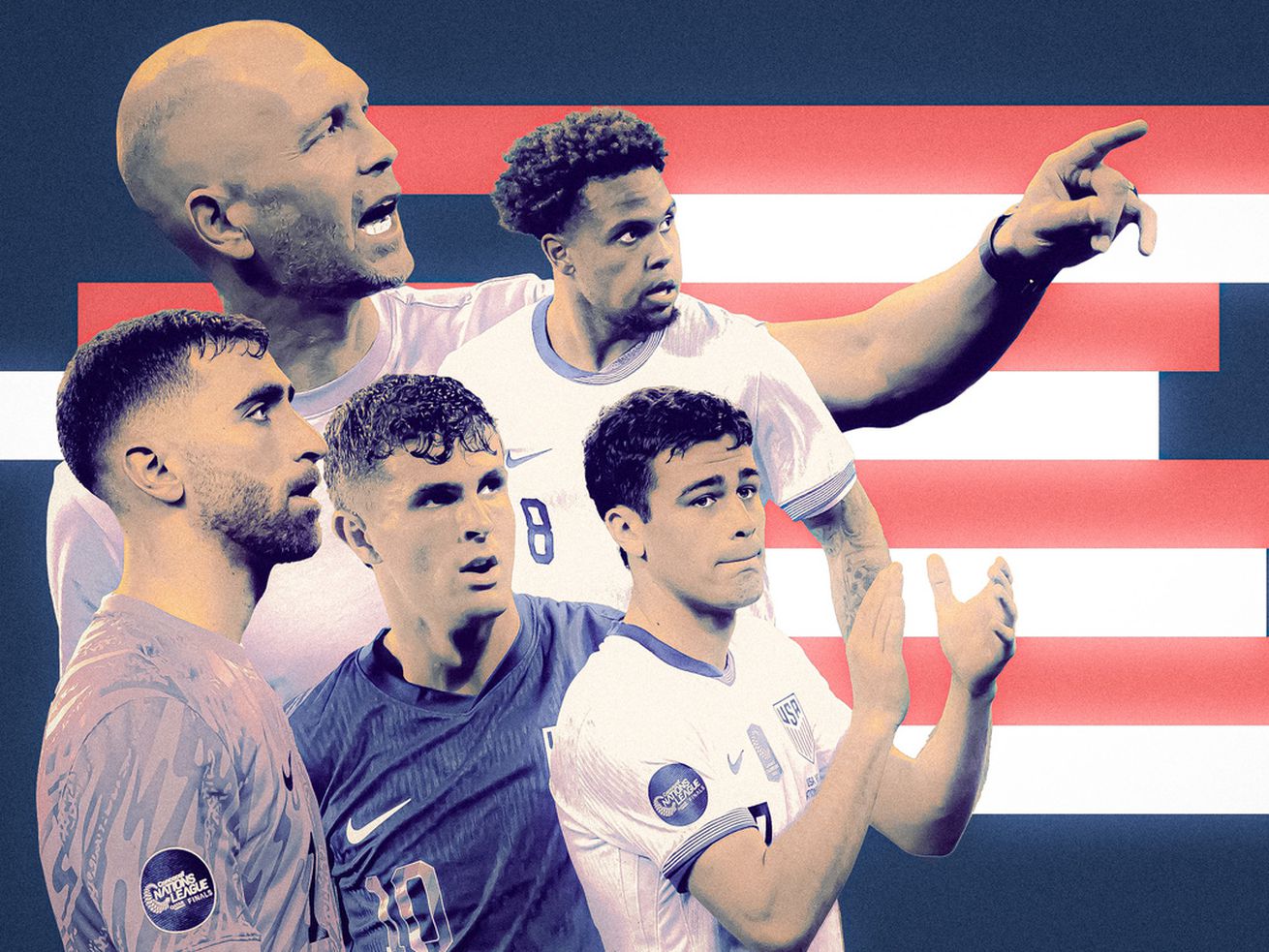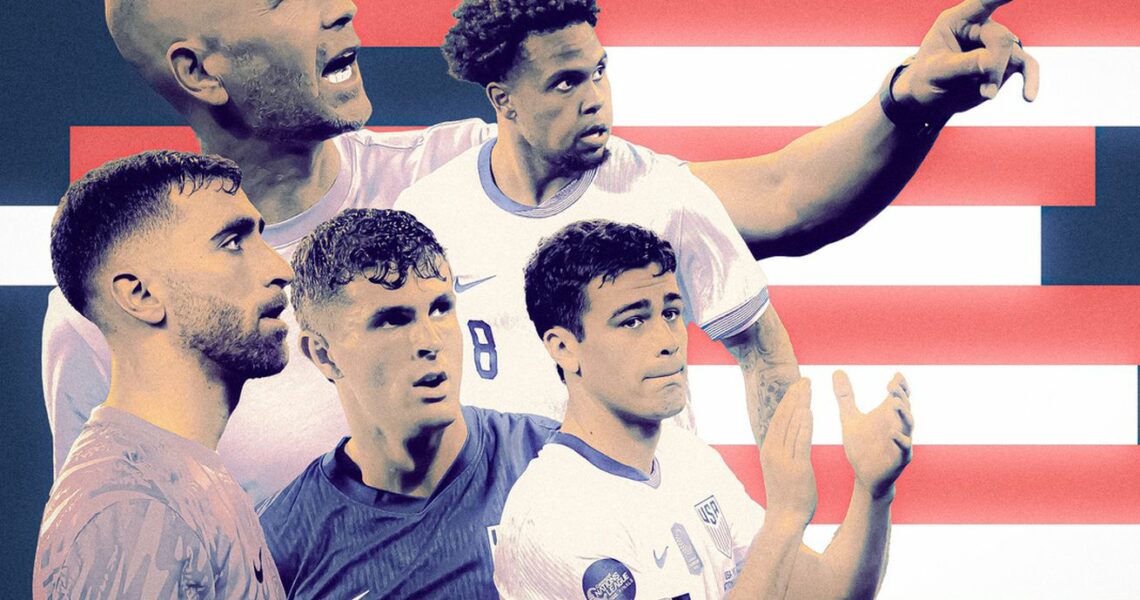
Ahead of Copa América, it’s not clear what progress and success will look like for Gregg Berhalter’s USMNT
When the United States took the field in its first pre–Copa América friendly against Colombia on June 8, the Americans made history before anyone touched a ball. For the first time, all 11 members of the U.S. starting lineup belonged to a club team in one of Europe’s top five leagues. The Americans’ “golden generation” of talent had finally, fully broken through at some of Europe’s top clubs. Borussia Dortmund, Juventus, AC Milan, AS Monaco, Fulham, Bournemouth, and Celta Vigo are all represented on the team.
Getting top Americans to play in the best leagues abroad has been a priority of the U.S. Soccer Federation for years. With that dream realized, surely you’d expect America to be competitive with one of the top teams in South America in a friendly on U.S. soil. Instead, the Americans made history on the pitch in a different way.
A second-half collapse against the Colombians led to a 5-1 defeat. It was the most goals the U.S. had conceded in a match in 15 years, and just the second time since 1990 that they’d allowed five. In possession, the United States made consistent mistakes trying to play out of its half under Colombian pressure, and high turnovers led to chance after chance for Colombia, plus three goals conceded, in the final 30 minutes. The once reliable goalkeeper Matt Turner, who would go on to have 11 saves in the Brazil game, struggled with his shot stopping against Colombia.
If the national team had hoped to use this match to draw in casual fans who likely haven’t watched any USMNT matches since the World Cup 18 months ago, the Colombia loss did the exact opposite. In a stadium that appeared to be at least 60 percent Colombian fans, the Americans’ individual defensive errors kept piling up. Berhalter rang some alarm bells with his comments the next day.
“From the 75th minute on, it was, I think, a lack of respect for our opponent and the game of soccer, what we were doing,” Berhalter said.
A chance for a marquee-friendly win outside CONCACAF came and went. The Americans did respond to that embarrassing loss with a 1-1 draw against Brazil, but the lack of a big international win remains one of the biggest criticisms of Berhalter as the Americans prepare to kick off play against Bolivia in Group C of Copa América on Sunday. Berhalter has five wins in 19 matches against teams in the FIFA top 20 since he became manager in 2018, and four of them came against Mexico (the other was a 1-0 triumph against Iran in the 2022 World Cup). Success just hasn’t translated against teams outside CONCACAF, despite the squad’s improving talent baseline.
The USMNT has been drawn into a group that includes Panama and Uruguay, along with Bolivia, which leaves them heavy favorites to qualify for the quarterfinals. They’re guaranteed at least one marquee matchup—against surging Uruguay in the final group stage match—and potentially more if they reach the knockouts. Anything short of second place in the group would be a disastrous result that could leave Berhalter’s seat extremely hot.
If the United States advances from the top-heavy Group C, a likely quarterfinal matchup awaits against Colombia or Brazil. Just two years before the United States cohosts the 48-team World Cup (with Mexico and Canada), it’s not imminently clear what would constitute success for the Americans in this tournament. Would a close quarterfinal loss to Brazil or even Colombia be enough to assuage concerns about whether or not the United States is making progress under Berhalter?
The talent pool that Berhalter has to pick from is arguably deeper than that of any U.S. squad in history. But in the 18 months since Qatar, the lack of club minutes for Gio Reyna and Tyler Adams due to injuries, as well as the fact that a true European star hasn’t developed alongside Christian Pulisic, has left the United States and its manager at a crossroads entering this tournament.
Its 2022 World Cup performance served as a perfect Rorschach test for the national team, depending on one’s preconceived notions about its talent level and Berhalter himself. Detractors will point to how easily the Netherlands played through the U.S. in the match that mattered most. Others will claim that the Americans’ competitive draw with England and their progression beyond the group are a job well done and a table setter for the golden generation’s peak World Cup in 2026.
The United States hasn’t had that many opportunities to get competitive games against top-tier sides worldwide. After Europe added the Nations League, another tournament for its teams to compete against one another, CONCACAF added its own. There are fewer windows open for the U.S. to schedule friendlies because of the extra CONCACAF Nations League matches, and many European and South American teams are unavailable because of matches within their own confederations. CONCACAF is a much weaker confederation, especially after Mexico’s downturn, and the U.S. no longer faces enough challenges to truly evaluate where it stands on the global stage.
Berhalter has prioritized improving the United States’ in-possession structure, but the USMNT hasn’t always fared well when facing more talented teams. The similarities between the 3-1 loss to the Netherlands at the World Cup and the friendly against Colombia should make even the pro-Berhalter camp uncomfortable. The United States kept 58 percent of the ball against the Dutch and controlled many midfield exchanges. They outshot the Dutch 17-11, but it was far too easy for the Netherlands to play through the U.S. in transition and create big scoring chances from the center of the penalty area.
“The United States didn’t adapt,” then–Dutch manager Louis van Gaal said after that win. “They didn’t adjust. We made our tactical plan based on [targeting the flanks].”
Fullbacks Sergiño Dest and Antonee Robinson are two of the most aggressive in the international game, but the Dutch picked on Dest’s defensive deficiencies in that match. His ACL injury, suffered when playing for PSV Eindhoven in April, has left Berhalter with his biggest lineup question of the summer: how to replace Dest at right back.
Tim Weah played right wing for Juventus at various points this season, but Berhalter opted to start Borussia Monchengladbach’s Joe Scally at right back in the friendlies against Colombia and Brazil. Berhalter kept Weah in the lineup as a right winger, and he scored a goal against Colombia.
Most importantly, Scally held up admirably against two of the best wide forwards in the world—Colombia’s Luis Diaz and Brazil’s Vinicius Junior. He has seemingly earned the job at right back, with Shaq Moore as the “break glass in case of emergency” option behind him. Scally, Tim Ream, Chris Richards, and Antonee Robinson are the expected back four against Bolivia. Ream, 36, looked a step slow at times defending in space in the friendlies, but his on-ball passing and ball-carrying ability remain crucial priorities in Berhalter’s tactical system.
Adams started every match for the United States in the World Cup, but Johnny Cardoso’s emergence as a potential defensive midfielder replacement last summer was critical given Adams’s injury history. Adams played only 15 minutes in the two warm-up friendlies and has barely played at the club level for a full year. Cardoso makes sense as the more defensive option next to mainstay Weston McKennie. Berhalter could also choose Yunus Musah, the more progressive option, over Cardoso. Either way, a bunch of bodies will likely rotate through the American midfield, given that Adams is lacking the match fitness to play a full 90 minutes.
Striker Josh Sargent was included in the 26-man squad even though he missed both friendlies with a foot injury, but he’s not expected to be a starter. Copa América is Folarin Balogun’s first major tournament with the USMNT. The Monaco striker will have Weah, Reyna, and star man Pulisic playing behind him. Balogun was born in New York, raised in London, and played youth internationals for England but is now locked in to play for the U.S. at the senior level.
The United States entered Qatar without a clear first-choice striker option, leaving them shorthanded in creating quality chances from dangerous positions despite all their possession dominance. Balogun could be the solution to these problems.
Some feel that the Americans’ current talent pool would be better suited by relying on the dribbling skills of McKennie, Pulisic, and Reyna in a more pragmatic and direct attacking approach on the break. They don’t have a consistently elite midfielder with the passing range to break open opposition defenses from settled possessions.
Some of the Americans’ best chances against Brazil came from more direct attacking play. Robinson’s chipped ball over the top to Ricardo Pepi never found him but was instead nodded down to Musah, who forced Alisson into a save from 25 yards. Pulisic’s elite dribbling ability allowed him to beat two men to draw the foul and eventually score the ensuing free kick from just outside the penalty area. The Americans’ best chance of the match came from a throw-in to Brenden Aaronson behind the Brazil defense and a cutback to Pulisic that Alisson saved.
Regardless of what outsiders and fans think of Berhalter, the US Soccer Federation gave him a contract to coach through 2026, and the key leaders in the squad still appear to vouch for him in the role. An extreme result could force the federation’s hand, but the most likely scenario is that the United States will reach the knockouts of this tournament, lose to a superior side, and then enter the 2026 cycle in a position similar to where they are right now.
It’s not clear that there’s an available and willing upgrade over Berhalter, and it’s even less clear that this golden generation of American talent is truly that much better than past generations. The squad’s depth has undoubtedly improved, and the clubs that they play for are as big as ever. But without that marquee win or moment, the USMNT is still searching for this generation’s identity.

